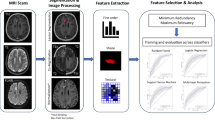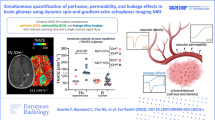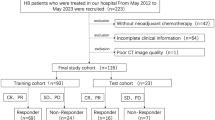Abstract
Objectives
We aimed to evaluate the prognostic value of dynamic susceptibility contrast (DSC) MR perfusion in elderly patients with glioblastomas (GBM).
Methods
Thirty five patients aged ≥65 and 35 aged <65 years old, (referred to as elderly and younger, respectively) were included in this retrospective study. The median relative cerebral volume (rCBV) from the enhancing region (rCBVER-Med) and immediate peritumoral region (rCBVIPR-Med) and maximum rCBV from the enhancing region of the tumor (rCBVER-Max) were compared and correlated with survival data. Analysis was repeated after rCBVs were dichotomized into high and low values and after excluding elderly patients who did not receive postoperative chemoradiation (34.3 %). Kaplan-Meyer survival curves and parametric and semi-parametric regression tests were used for analysis.
Results
All rCBV parameters were higher in elderly compared to younger patients (p < 0.05). After adjustment for age, none were independently associated with shorter survival (p > 0.05). After rCBV dichotomization into high and low values, high rCBV in elderly was independently associated with shorter survival compared to low rCBV in elderly, or any rCBV in younger patients (p < 0.05).
Conclusion
rCBV can be an imaging biomarker to identify a subgroup of GBM patients in the elderly with worse prognosis compared to others.
Key Points
• GBM perfusion parameters are higher in elderly compared to younger patients.
• rCBV can identify a subgroup of elderly patients with worse prognosis.
• rCBV can be an imaging biomarker for prognostication in GBM.
• The identified elderly patients may benefit from anti-angiogenic treatment.




Similar content being viewed by others
Abbreviations
- rCBV:
-
Relative cerebral blood volume
- rCBVER-Med :
-
Median rCBV in the enhancing region
- rCBVIPR-Med :
-
Median rCBV in the immediate peritumoral region
- rCBVER-Max :
-
Maximum rCBV in the enhancing region
References
Stupp R, Mason WP, van den Bent MJ et al (2005) Radiotherapy plus concomitant and adjuvant temozolomide for glioblastoma. N Engl J Med 352:987–996
Yovino S, Grossman SA (2011) Treatment of glioblastoma in “elderly” patients. Curr Treat Options in Oncol 12:253–262
Laperriere N, Weller M, Stupp R et al (2013) Optimal management of elderly patients with glioblastoma. Cancer Treat Rev 39:350–357
Thakkar JP, Dolecek TA, Horbinski C et al (2014) Epidemiologic and molecular prognostic review of glioblastoma. Cancer Epidemiol Biomarkers Prev 23:1985–1996
Omuro A, DeAngelis LM (2013) Glioblastoma and other malignant gliomas: a clinical review. JAMA 310:1842–1850
Sahebjam S, McNamara M, Mason WP (2012) Management of glioblastoma in the elderly. Clin Adv Hematol Oncol 10:379–386
Scott JG, Suh JH, Elson P et al (2011) Aggressive treatment is appropriate for glioblastoma multiforme patients 70 years old or older: a retrospective review of 206 cases. Neuro-Oncology 13:428–436
Bozdag S, Li A, Riddick G et al (2013) Age-specific signatures of glioblastoma at the genomic, genetic, and epigenetic levels. PLoS One 8:e62982
Wang Y, Jiang T (2013) Understanding high grade glioma: molecular mechanism, therapy and comprehensive management. Cancer Lett 331:139–146
Leon SP, Folkerth RD, Black PM (1996) Microvessel density is a prognostic indicator for patients with astroglial brain tumors. Cancer 77:362–372
Friedman HS, Prados MD, Wen PY et al (2009) Bevacizumab alone and in combination with irinotecan in recurrent glioblastoma. J Clin Oncol 27:4733–4740
Hanson JA, Hsu FP, Jacob AT, Bota DA, Alexandru D (2013) Antivascular endothelial growth factor antibody for treatment of glioblastoma multiforme. Perm J 17:68–74
Khasraw M, Simeonovic M, Grommes C (2012) Bevacizumab for the treatment of high-grade glioma. Expert Opin Biol Ther 12:1101–1111
Minniti G, Lanzetta G, Scaringi C et al (2012) Phase II study of short-course radiotherapy plus concomitant and adjuvant temozolomide in elderly patients with glioblastoma. Int J Radiat Oncol Biol Phys 83:93–99
Reyngold M, Lassman AB, Chan TA, Yamada Y, Gutin PH, Beal K (2012) Abbreviated course of radiation therapy with concurrent temozolomide for high-grade glioma in patients of advanced age or poor functional status. J Neuro-Oncol 110:369–374
Jain R, Gutierrez J, Narang J et al (2011) In vivo correlation of tumor blood volume and permeability with histologic and molecular angiogenic markers in gliomas. Am J Neuroradiol 32:388–394
Sugahara T, Korogi Y, Kochi M et al (1998) Correlation of MR imaging-determined cerebral blood volume maps with histologic and angiographic determination of vascularity of gliomas. Am J Roentgenol 171:1479–1486
Jain R, Poisson L, Narang J et al (2013) Genomic mapping and survival prediction in glioblastoma: molecular subclassification strengthened by hemodynamic imaging biomarkers. Radiology 267:212–220
Saraswathy S, Crawford FW, Lamborn KR et al (2009) Evaluation of MR markers that predict survival in patients with newly diagnosed GBM prior to adjuvant therapy. J Neuro-Oncol 91:69–81
Hirai T, Murakami R, Nakamura H et al (2008) Prognostic value of perfusion MR imaging of high-grade astrocytomas: long-term follow-up study. Am J Neuroradiol 29:1505–1510
Law M, Young RJ, Babb JS et al (2008) Gliomas: predicting time to progression or survival with cerebral blood volume measurements at dynamic susceptibility-weighted contrast-enhanced perfusion MR imaging. Radiology 247:490–498
Nghiemphu PL, Liu W, Lee Y et al (2009) Bevacizumab and chemotherapy for recurrent glioblastoma: a single-institution experience. Neurology 72:1217–1222
Wick W, Platten M, Meisner C et al (2012) Temozolomide chemotherapy alone versus radiotherapy alone for malignant astrocytoma in the elderly: the NOA-08 randomised, phase 3 trial. Lancet Oncol 13:707–715
Boxerman JL, Prah DE, Paulson ES, Machan JT, Bedekar D, Schmainda KM (2012) The Role of preload and leakage correction in gadolinium-based cerebral blood volume estimation determined by comparison with MION as a criterion standard. Am J Neuroradiol 33:1081–1087
Johnson G, Wetzel SG, Cha S, Babb J, Tofts PS (2004) Measuring blood volume and vascular transfer constant from dynamic, T(2)*-weighted contrast-enhanced MRI. Magn Reson Med 51:961–968
Rosen BR, Belliveau JW, Vevea JM, Brady TJ (1990) Perfusion imaging with NMR contrast agents. Magn Reson Med 14:249–265
Weisskoff RMBJ, Kwong KK, Rosen BR (1993) Functional MR imaging of capillary hemodynamics. In: Potchen EJHE, Siebert JE, Gottschalk A (eds) Magn Reson Angio. Mosbey, St. Louis, pp 473–484
Wang S, Kim S, Chawla S et al (2011) Differentiation between glioblastomas, solitary brain metastases, and primary cerebral lymphomas using diffusion tensor and dynamic susceptibility contrast-enhanced MR imaging. Am J Neuroradiol 32:507–514
Filippini G, Falcone C, Boiardi A et al (2008) Prognostic factors for survival in 676 consecutive patients with newly diagnosed primary glioblastoma. Neuro-Oncology 10:79–87
McKeever PE, Junck L, Strawderman MS et al (2001) Proliferation index is related to patient age in glioblastoma. Neurology 56:1216–1218
Verhaak RG, Hoadley KA, Purdom E et al (2010) Integrated genomic analysis identifies clinically relevant subtypes of glioblastoma characterized by abnormalities in PDGFRA, IDH1, EGFR, and NF1. Cancer Cell 17:98–110
Camara-Quintana JQ, Nitta RT, Li G (2012) Pathology: commonly monitored glioblastoma markers: EFGR, EGFRvIII, PTEN, and MGMT. Neurosurg Clin N Am 23:237–246, viii
Chinot OL, Macdonald DR, Abrey LE, Zahlmann G, Kerloeguen Y, Cloughesy TF (2013) Response assessment criteria for glioblastoma: practical adaptation and implementation in clinical trials of antiangiogenic therapy. Curr Neurol Neurosci Rep 13:347
Batchelor TT, Gerstner ER, Emblem KE et al (2013) Improved tumor oxygenation and survival in glioblastoma patients who show increased blood perfusion after cediranib and chemoradiation. PNAS 110:19059–19064
Sorensen AG, Emblem KE, Polaskova P et al (2012) Increased survival of glioblastoma patients who respond to antiangiogenic therapy with elevated blood perfusion. Cancer Res 72:402–407
Acknowledgements
The scientific guarantor of this publication is Dr. Suyash Mohan. The authors of this manuscript declare no relationships with any companies, whose products or services may be related to the subject matter of the article. The authors state that this work has not received any funding. Rahim Moineddin PhD, Research Services Unit, Dalla Lana School of Public Health, University of Toronto kindly provided statistical advice for this manuscript. Also Edward H. Herskovits, MD PhD, who is one of the authors, has significant statistical expertise and provided statistical advice. Institutional Review Board approval was obtained. Written informed consent was waived by the Institutional Review Board. A subgroup of study subjects have been previously reported in the American Society of Neuroradiology meeting in San Diego in 2012. Methodology: retrospective, case-control study, performed at one institution.
Author information
Authors and Affiliations
Corresponding author
Rights and permissions
About this article
Cite this article
Jabehdar Maralani, P., Melhem, E.R., Wang, S. et al. Association of dynamic susceptibility contrast enhanced MR Perfusion parameters with prognosis in elderly patients with glioblastomas. Eur Radiol 25, 2738–2744 (2015). https://doi.org/10.1007/s00330-015-3640-4
Received:
Revised:
Accepted:
Published:
Issue Date:
DOI: https://doi.org/10.1007/s00330-015-3640-4




